Winter brings cozy fires, warm blankets, and spicy hot chocolate. But it also brings shorter days, lower temperatures, and many more days indoors. Every year, we try to avoid cabin fever and focus on our winter hobbies to stay active, entertained, and mentally stimulated. Whether it’s upping our kitchen skills, crafting, or learning a new language, hobbies help us break up the monotony of the cold season and make excessive indoor time more enjoyable.
1. Watercolor Painting

Getting Artsy
One of the most accessible and affordable art forms to start with is watercolor painting. The beauty of watercolor lies in its unpredictability and the soft, dreamy effects that can be achieved. Plus, it’s a forgiving medium, perfect for beginners. You can start with a basic set, some brushes, and watercolor paper or watercolor sketchbook, all of which can be found for under $50.
How to Begin
Start by learning the basic techniques like wet-on-wet and wet-on-dry. Experiment with mixing colors and creating gradients. The key is to be patient and let the watercolor do its thing. Remember, it’s not about creating a masterpiece, but about enjoying the process and expressing your creativity.
Sources to Learn Watercolor Painting
If you’d like to learn watercolor with a little bit of instruction, you can find so many tutorials on YouTube, Instagram, or Pinterest. Some great books (like this one) are available as well. For instant downloads of watercolor instruction or template pages, HandgemaltStudio on Etsy has some that are positively gorgeous and drool-worthy!! If you prefer more formal instruction, you can take a community education class. An online class I’ve been looking at for a while is one offered by Andrea Nelson. Her Instagram account is full of inspiration and her watercolor class is on my wish list! There are also loads of watercolor lessons on Skillshare.
2. Get Lost in a Good Book

Rediscover Reading
There’s nothing quite like curling up with a good book and a nice hot cup of tea on a cold winter day. I’d consider myself an avid reader (over 160 books read last year) but reading is a fairly new hobby of mine. I’ve found reading to be a great way to relax and escape. It’s my favorite way to learn new things and gain entirely different perspectives. Whether you prefer fiction or non-fiction, thrillers or romance, classics or contemporary works, there are endless possibilities for reading out there.
How to Make Reading a Habit
If you’re not already a regular reader, start small. Choose a book that interests you and set aside a specific time each day to read, even if it’s just for a few minutes. Don’t be afraid to give up on a book if it’s not working for you. (I try to get at least 25% through a book before I give up). You may also want to have a couple of books you read through depending on your mood or interest that day. I also like to switch between listening to and reading (the same book) as much as possible. Over time, you may just find that you look forward to this quiet, peaceful time and that you’re reading more and more.
Reading Inspiration & Sources
My favorite places for reading inspiration are people I follow on Instagram (surprise surprise!) and Goodreads. If you’re looking for a book to try, real-life people are my favorite source. I get 99% of my books free from my library (Overdrive or Libby App for digital) or through my Amazon Unlimited account (some books are audio-enabled). If you’d like to listen to audiobooks more than reading, my audiobook service is Audiobooks.com. I don’t have the service but I will buy books if they are a sweet deal. (Not a fan of Audible or Chirp – which I may dive into in a separate post.)
3. Develop Your Culinary Skills

Get to Cooking
You all know I love food based on all the recipes I’ve shared. Cooking is a practical skill that can also be a lot of fun. It’s another creative outlet that can be very satisfying and fun. Winter is a great time to experiment with new recipes and techniques. You can try your hand at baking bread (such as my 4H Dinner Rolls), make homemade yogurt, or attempt that complicated recipe you’ve been eyeing (my French Chocolate Mousse is a great one to try).
Start Simple
If you’re new to cooking, start with simple recipes that don’t require a lot of specialized equipment. As you gain confidence, you can start experimenting with more complex dishes. Remember, the goal is to enjoy the process as much as the final product.
Cooking Challenges & Accountability
You may want to consider a cooking challenge to get you going. Sally’s Baking Addiction has their monthly baking challenge going on this year. I’m joining her challenges, which are a brilliant way to try something along with a community of fellow recipe enthusiasts. Another idea for getting you out of your cooking comfort zone is to host a specific cuisine potluck with friends. One year, we did this with a Russian food theme and were amazed at the food we all produced. Skillshare also has some great cooking lessons available that we’ve enjoyed as a family.
4. Start a Fitness Routine at Home
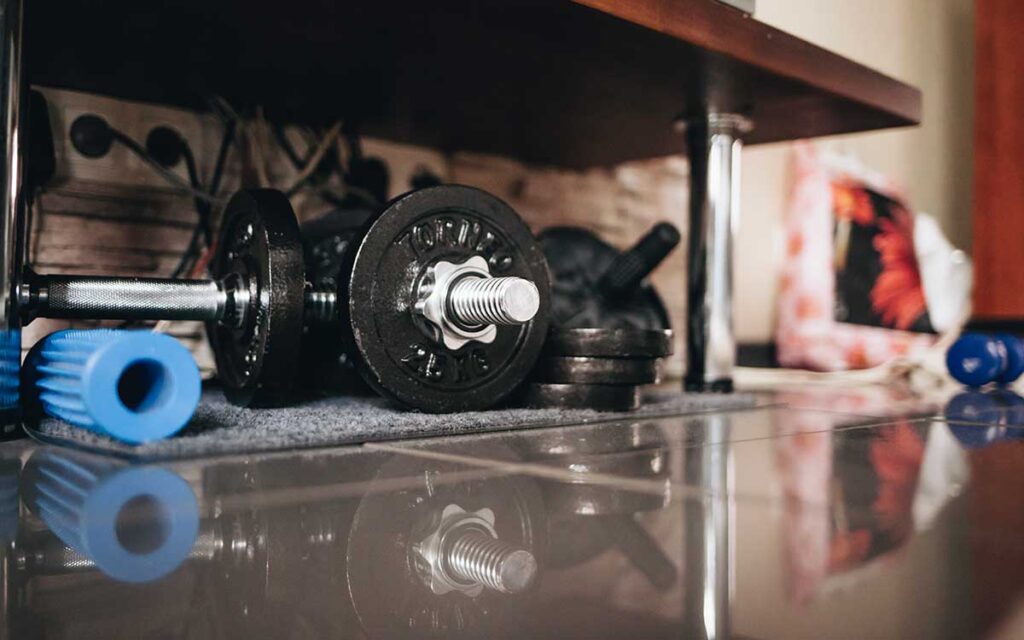
Stay Active Indoors
One of the hardest things with wintertime is the limitations on outdoor activities. While there are winter sports available, it’s still a good time to figure out exercise indoors. Getting that workout endorphin release is especially important during the winter months when most people tend to slow down and become more sedentary. There are plenty of exercises and workouts you can do from the comfort of your own home, without any fancy equipment.
Fitness Options to Consider
Consider bodyweight exercises like push-ups, squats, and lunges (I have a series of bodyweight-only workouts), or try online yoga, dance classes, or workout video streaming. If you’re new to exercise, start slowly and gradually increase the intensity of your workouts. Remember to listen to your body and make adjustments as needed. Most importantly, figure out what motivates and works for you to stay motivated in your exercise. I need accountability and a little dose of competition so I attend a gym that does group workouts.
5. Organize Recipes into a Cookbook
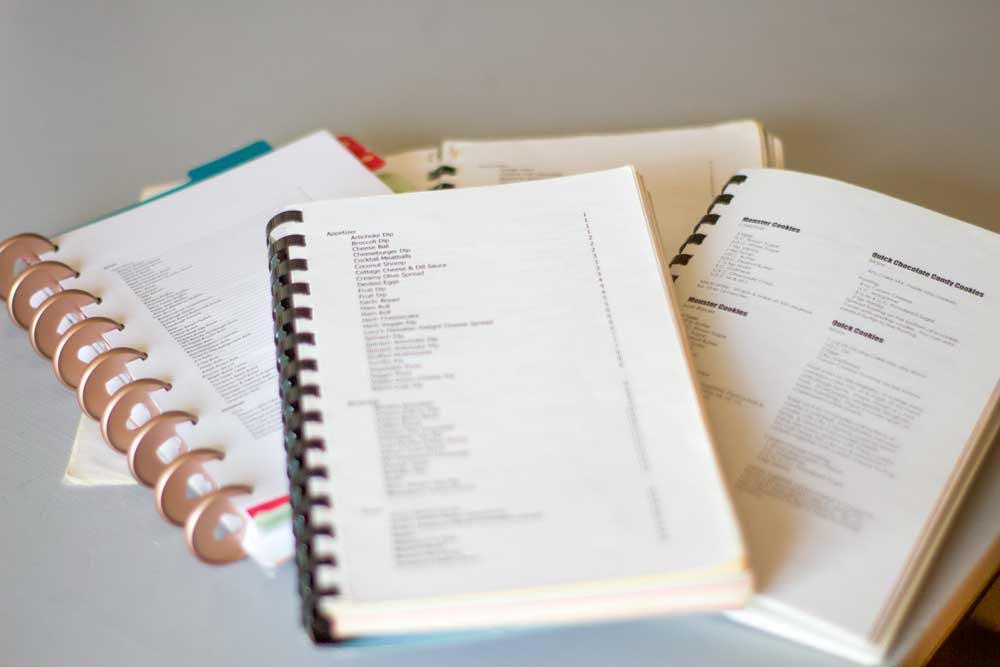
Create a Family Heirloom
One great way to preserve family history is to gather recipes from your loved ones and organize them into a treasure for years to come. I’ve written about this extensively in a series of posts that you can start by reading here or here). This is something my mom and I have done for many years and I’ve kept my own personal cookbook up to date for several years now. The slower winter months are my favorite time to update my recipes and add new ones I’ve discovered or created. Through this cookbook, my kids will have all their favorite foods I make available for when they leave the nest.
Format Options
Picking the format for your cookbook is important upfront. I don’t want to get too in the weeds explaining the different formats available, but you have quite a few options. You may want to use a cookbook-making company such as CreateCookbooks or HeritageBooks (both are popular but I don’t have personal experience with either). If you are a DIYer, you can use professional desktop publishing software such as InDesign (which is complicated to learn but gives you complete control of your cookbook). Canva is another option, but you may want to use CanvaPro (paid version) and purchase a template to make the process simpler. My favorite and most cost-effective way to create my cookbooks is to use Microsoft Word. As I mentioned, I wrote about this quite a bit in the past and you can check out this topic here.
6. Learn a New Language
Expand Your Horizons
Learning a new language might be the most challenging but rewarding of the winter hobbies I’m sharing.. It’s not only a great mental workout, but it can also open up new experiences. With a variety of language learning apps and online resources available, you can practice anytime, anywhere.
Where to Start
Choose a language that interests you or that will be useful in your personal or professional life. Start with the basics and work your way up, practicing a little bit each day. An excellent app that we’ve enjoyed learning through is Mango. The lessons start VERY simple and I enjoy the feature of recording our speaking to understand the inflection and pace of the language we’re learning. Just remember, consistency is key when learning a new language.
7. Unleash Your Inner Writer

Express Yourself Through Words
If you love words and storytelling, why not try your hand at writing?! Whether you’re interested in creating short stories, penning a novel, poetry, or simply keeping a journal, writing can be a therapeutic and satisfying hobby.
Writing as a Hobby
Start by setting aside a specific time each day to write. Don’t worry about making it perfect; just focus on getting your thoughts and ideas down on paper. In my experience, the hardest part of writing is simply starting. So start. Over time, you’ll loosen up, improve your skills, and develop your own unique voice through this creative and no-cost idea from my winter hobbies.
8. Take Up Knitting or Crocheting
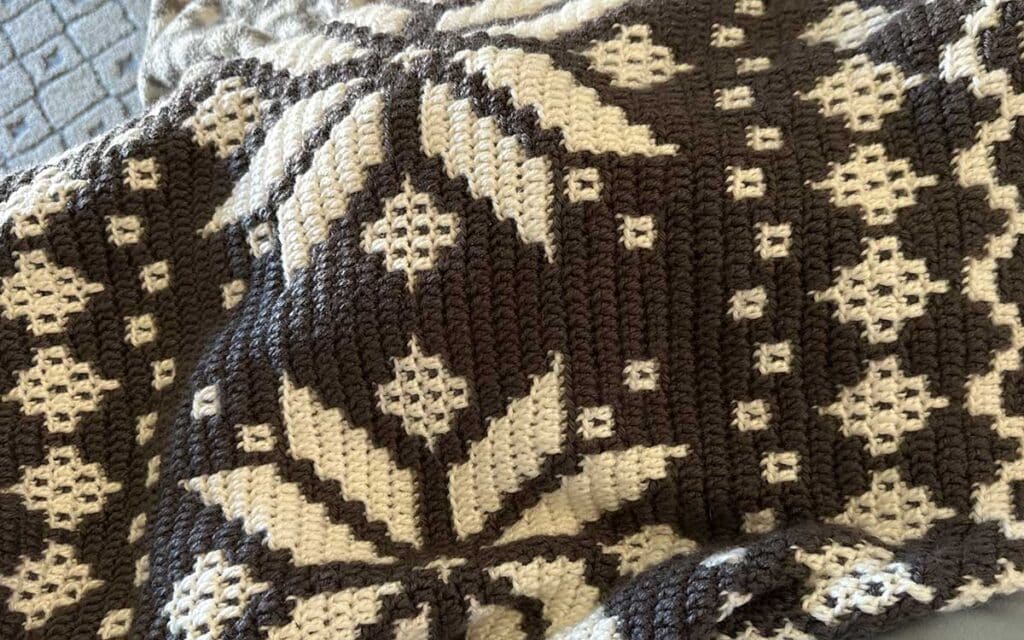
Create Cozy Crafts
Knitting and crocheting are ideal winter hobbies, though they can be enjoyed year-round. Not only can you create warm and cozy items like scarves, hats, and blankets, but the repetitive motions can be very relaxing and meditative. I’ve been seeing articles pop up on my feed lately that talk about just how good working with your hands is for your brain and mental health, (such as this one from Psychology Today). The great thing about knitting and crocheting specifically is that you can take your craft with you nearly anywhere.
Tips for Beginners
If you’re new to knitting or crocheting, start with a simple project and work your way up to more complex patterns. There are plenty of tutorials and guides available online or through Skillshare to help you get started. I tried knitting years ago and didn’t get too far with it, but I LOVE crocheting. A great beginner project to learn crochet is my granny square Christmas stocking pattern. Start now and you’ll have stockings ready for your entire family next Christmas!
9. Explore the World of Photography

Capture the Beauty of Winter
I might be trying to get you outdoors with #9 of my list of indoor winter hobbies, but hear me out. Even up here in South Dakota, we get some beautiful winter days. If you are interested in talking up a photography hobby, winter is a magical time with all the snow-covered trees and frosted landscapes. The soft, diffused light; the stark contrast between snow and sky; and the quiet stillness of a winter landscape – all of these can make for stunning photographs.
Indoor Photos Too
You can also start working on your indoor photography skills. You can get creative and work with the natural light from windows. Food photography is a great hobby to delve into and it works perfectly with creating your cookbook and all the new cooking skills you are developing.
Photography Tips
Regardless of your photography subject/place, you can make this as technical as you like with a fancy DSLR camera or just your smartphone. Look for online inspiration for what you find appealing in photos. Don’t be afraid to copy others until you improve your skills and expand your creativity. When shooting in winter, remember to protect your equipment from the cold and adjust your camera settings to account for the bright, reflective snow. I most often Google recommended settings for my DSLR or my iPhone camera so I can easily adjust for the type of photos I’m taking. Experiment with different angles, and perspectives, learn the Rule of Thirds, and don’t be afraid to get creative.
Years ago, we got a Skillshare account and I dove into many of the photography lessons. Learn, adjust, and practice. I’m by no means a great photographer, but I have enjoyed improving my photos over the years.
10. Dive Into DIY Home Projects
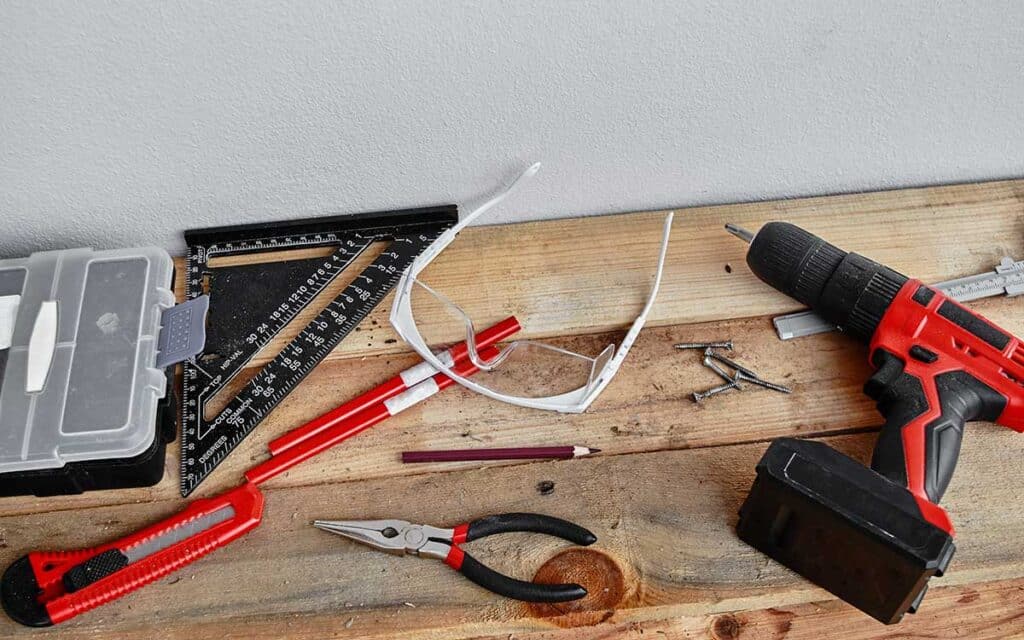
Improve Your Living Space
Winter is the perfect time to tackle those home improvement projects you’ve been putting off. Whether it’s organizing your closet, getting rid of stuff, painting a room, or building a bookshelf, DIY projects can be a fun and productive way to spend your indoor time.
DIY Project Ideas
Start with a project that matches your skill level and the tools you have on hand. There are countless tutorials and guides available online through Skillshare or YouTube to help you with your project, from simple crafts to major renovations. If you are interested in a beginner woodworking project and garden, you’ll love my DIY Garden Hod.
11. Start Gardening

Prepare for Spring or Bring Nature Indoors
Of all these winter hobbies, gardening is probably the best one to help us look forward to the changing seasons. If you’d like to try your hand at outdoor gardening or you want to bring some greenery indoors, wintertime is the perfect time to start gardening. This is the perfect time to plant your seeds (and save a pretty penny compared to buying seedlings from a nursery) for outdoor planting this coming spring. From herbs and vegetables to flowers, there are so many seedlings you can start now. If you’re looking for more long-term indoor plants, succulents, bonsai trees, and terrariums are excellent choices of plants that thrive indoors.
Tips for Indoor Gardening
If you’re planting seeds for outdoor gardening, consider the growing season and your USDA Plant Hardiness Zone. Purchase simple seed starting trays (or make newspaper pots), a few grow lights (I have this set), seed starting mix, and research what is best to start seeds indoors and when. For long-term indoor gardening, choose plants that are well-suited to your home’s light levels and temperature. Remember to water and fertilize them regularly, and keep an eye out for pests.
12. Up Your Food Preservation Game
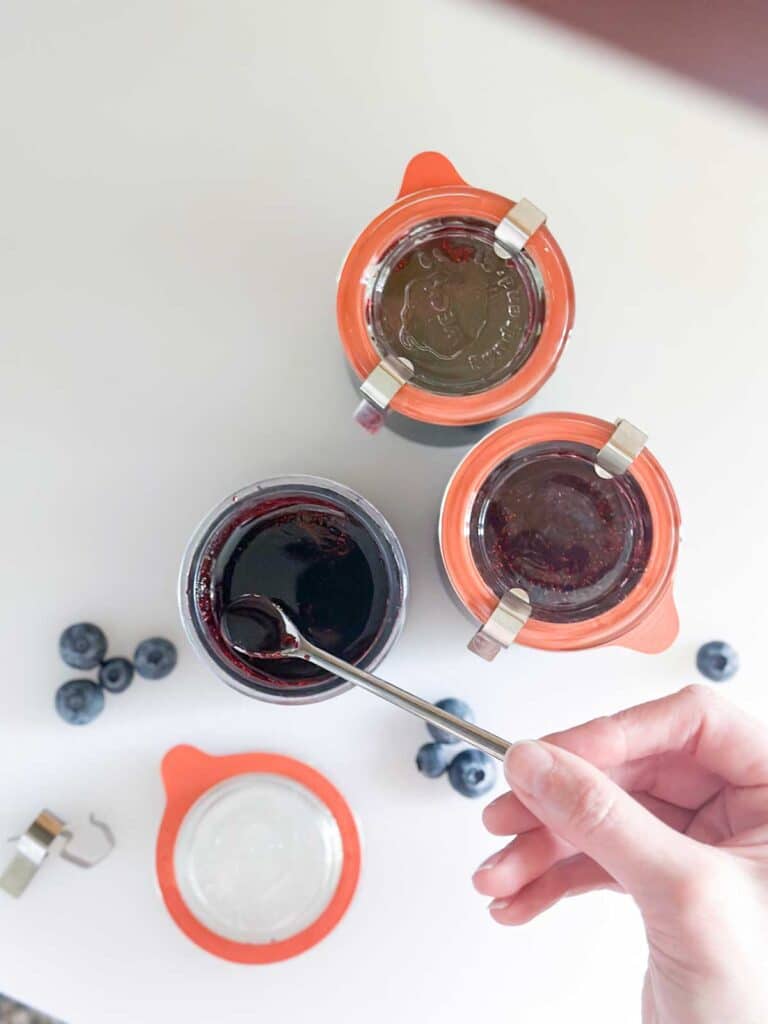
Learn Winter Hobbies During Slow Months
Food preservation is not only an extremely useful skill, but it is one of my favorite winter hobbies that is very rewarding as well. There are various food preservation methods such as waterbath canning, pressure canning, fermenting, or dehydrating foods. Winter months are the perfect time to take up this hobby, life is generally slower with more time available. Unfortunately, many foods are most abundant during summer and fall, which is when we are all generally more active and don’t have the time to learn to preserve food.
Winter Foods to Preserve
Depending on your interests and food preferences, you likely have food options available to dip your toe into food preservation. You can always try your hand at dehydrating meat for jerky, making fruit leathers with applesauce or pureed fruit, pressure-canning beef stock (or chicken), pressure-canning dried beans, or water bath canning homemade jam from frozen fruit (my frozen blueberry jam or rhubarb jam are favorites) or jelly from juice (we LOVE my chokecherry jelly from frozen chokecherries). By taking up a food preservation hobby now, you’ll be ahead of the learning curve when the busy summer and fall months arrive.
Conclusion of These 12 Winter Hobbies
Winter can be a hard time of the year. But it doesn’t have to be a season of boredom and inactivity. With the right winter hobbies, you can make the most of your indoor time, learn new skills, and have fun along the way. So bundle up, get cozy, and dive into learning and doing something this winter!
As an Amazon Associate, I earn from qualifying purchases at no extra cost to you. Thank you for your support!
